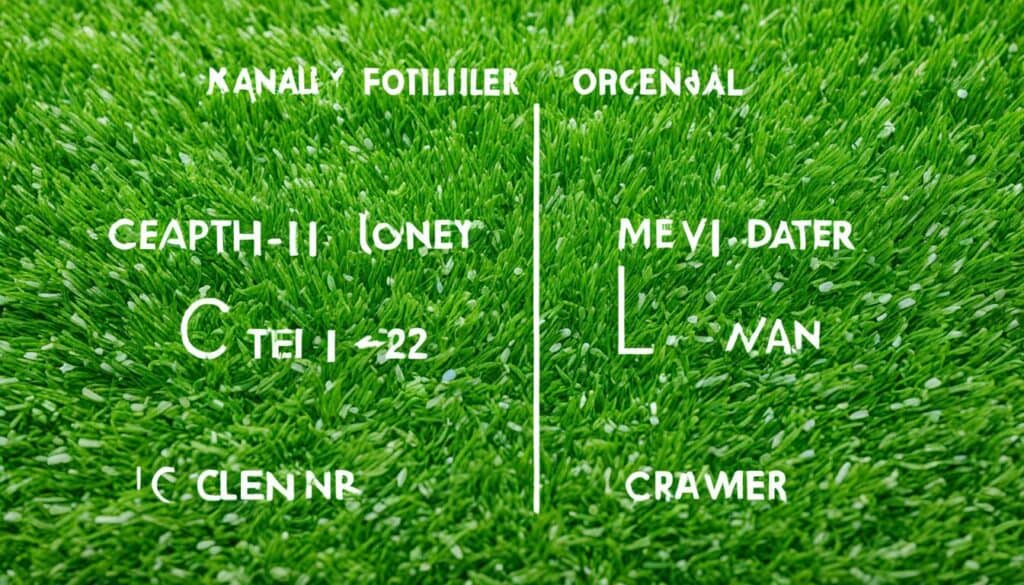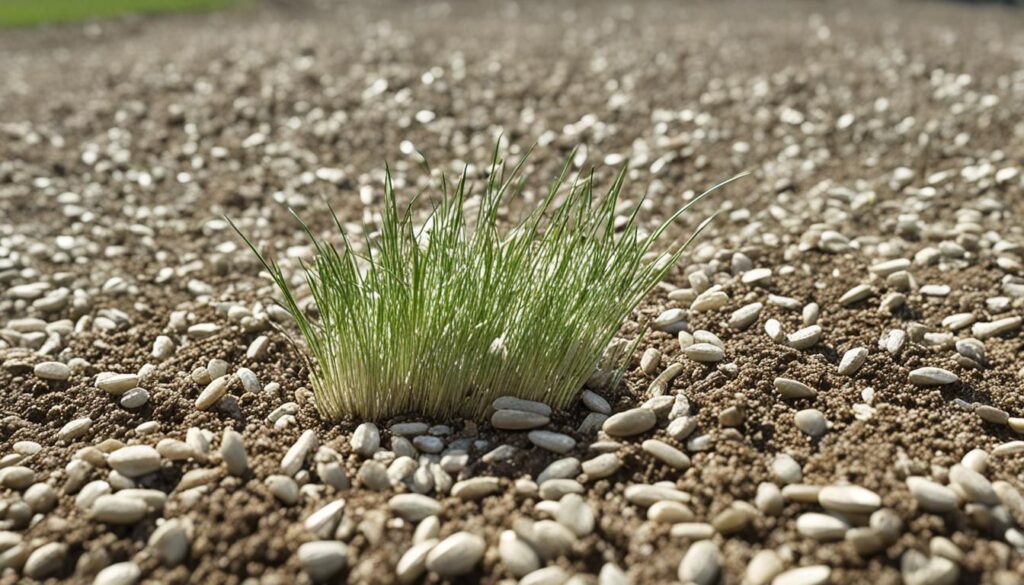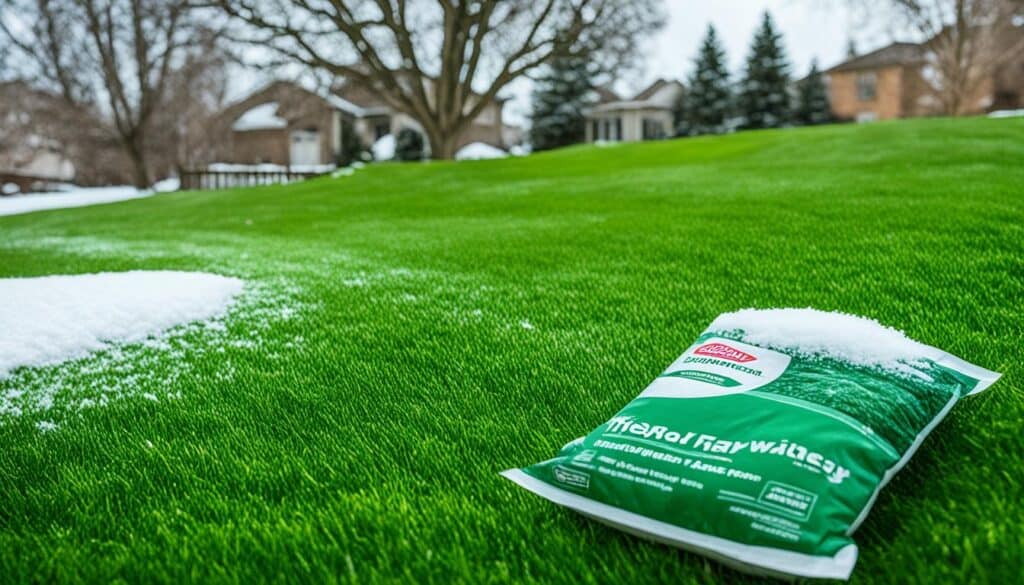How soon can I mow after putting down granular fertilizer? This is a question many homeowners ask to keep their lawns looking great. Fertilizing is key for healthy grass, but mowing too early can mess up its effects and harm your lawn. We’ll look at the best time to mow after fertilizing to make sure your grass gets the most from the nutrients.
Getting a lush, green lawn is all about balancing fertilizing and mowing. Granular fertilizers slowly release nutrients for your grass to take in. But cutting your lawn right after fertilizing can mess up this process, causing uneven growth and losing nutrients. Knowing when to wait before mowing helps you care for your lawn better and gets the best results.
Key Takeaways:
- Wait at least 24-48 hours after applying granular fertilizer before mowing your lawn.
- Mowing too soon can disrupt fertilizer absorption and lead to uneven grass growth.
- Adjust your mowing schedule to accommodate fertilization for optimal nutrient uptake.
- Water your lawn adequately after fertilizing to help activate the nutrients.
- Follow proper mowing techniques to avoid damaging fertilized grass.
Understanding Granular Fertilizer Absorption
Granular fertilizers are a top choice for keeping lawns healthy. But, to get the best results, knowing how they work and what affects their absorption is key. Unlike liquid fertilizers, which are quickly taken in by the grass, granular ones need more time and the right conditions to release their nutrients into the soil.
How Granular Fertilizer Works
Granular fertilizers are dry pellets packed with nutrients for your lawn. When you put them on the grass, they start to break down and dissolve in the soil. This takes time and depends on things like moisture, temperature, and soil type. As they dissolve, they release nutrients into the soil. These nutrients then get taken up by the grass roots, helping your lawn grow and stay healthy.
Factors Affecting Absorption Time
Several things can change how fast granular fertilizers are absorbed:
- Fertilizer type: Different granular fertilizers release nutrients at different rates, affecting how quickly they get into the soil and roots.
- Soil moisture: The soil needs to be moist for the fertilizer pellets to break down. Too dry soil slows things down, and too wet soil can wash the nutrients away before the grass can use them.
- Temperature: Warmer weather helps granular fertilizers break down faster, so nutrients get absorbed quicker. Cooler weather slows it down.
- Soil composition: The type of soil you have can also affect how fast the fertilizer absorbs. Sandy soils drain quickly, while clay soils hold moisture longer, changing how the pellets dissolve.
Granular fertilizers usually take 24 to 48 hours to fully absorb into the soil and roots. During this time, don’t mow your lawn to avoid messing up the absorption and spreading nutrients unevenly. Studies show that the best time for nutrient absorption is within the first 24 to 48 hours after applying the fertilizer.
Tip: To help your lawn take in nutrients better, mow it just before applying granular fertilizer. This lets the grass blades absorb the nutrients more effectively and spreads them out evenly.
Knowing how granular fertilizers work and what affects their absorption helps your lawn get the nutrients it needs to flourish. Always follow the instructions from the manufacturer and wait for the fertilizer to fully absorb before mowing or doing other lawn care tasks.
Consequences of Mowing Too Soon After Fertilizing
Mowing your lawn too soon after applying granular fertilizer can cause problems. Many homeowners are looking for advice on this topic. With over 22,000 views on “Mowing After Granular Fertilizer: Timing Guide,” it shows how important it is to know the risks.
Nutrient Loss and Waste
Mowing too soon after fertilizing can lead to losing nutrients. If the fertilizer hasn’t soaked into the soil, mowing can take away the granules. This means losing valuable nutrients. Testing shows that only a tiny bit of the granules stay after mowing a 1,000 sq ft area.
Also, finding granules in the bag after mowing shows nutrient waste. Labels warn that you can’t rake or blow out the granules from the turf. This is a problem for lawns that aren’t well-maintained.
Uneven Grass Growth
Mowing too soon after fertilizing can cause uneven grass growth. If nutrients aren’t spread evenly, some parts of the lawn may not get enough food. This can lead to patchy or uneven growth, especially in lawns cut very short.
“I’ve noticed that when I mow too soon after applying granular fertilizer, my lawn tends to have uneven growth patterns. It’s frustrating to see some areas thriving while others struggle.”
Potential Damage to Lawn Mower
Mowing over fertilizer granules can also harm your lawn mower. Stories suggest it’s hard to remove granules from the turf, especially with lots of leaves or dust. This can clog catchers, especially in places like golf greens or sports fields, and damage your mower.
| Consequence | Impact | Prevention |
|---|---|---|
| Nutrient Loss and Waste | Ineffective fertilization and wasted resources | Wait at least 24-48 hours before mowing |
| Uneven Grass Growth | Patchy and inconsistent lawn appearance | Allow granules to be absorbed fully |
| Potential Damage to Lawn Mower | Clogged catchers and worn mower blades | Ensure granules have settled into the soil |
To avoid these problems, wait 24 to 48 hours after applying fertilizer before mowing. This lets the granules soak into the soil. Also, watering the lawn after fertilizing helps the granules settle and reduces issues with mowing too soon.
Recommended Waiting Period Before Mowing
After putting granular fertilizer on your lawn, wait a bit before you mow. This lets the nutrients soak into the soil. It helps your grass grow strong and keeps your lawn mower safe.
General Guidelines for Granular Fertilizer
It’s smart to wait 24 to 48 hours before mowing after using granular fertilizer. This time lets the fertilizer dissolve and release its nutrients into the soil. Your grass can then easily take in these nutrients.
To prevent transfer of fertilizers, it is advised to stay off the grass for 24 to 48 hours after application.
Specific Waiting Times Based on Fertilizer Type
Waiting times can vary with different fertilizers. Some slow-release fertilizers need more time to work. Always check the product label for the best time to mow after applying.
| Fertilizer Type | Recommended Waiting Time Before Mowing |
|---|---|
| Quick-Release Fertilizer | 24 to 48 hours |
| Slow-Release Fertilizer | 48 to 72 hours |
| Organic Fertilizer | 24 to 48 hours |
| Weed and Feed Fertilizer | 24 to 48 hours |
After applying granular fertilizer, make sure to water your lawn well. This activates the fertilizer and helps your grass absorb the nutrients. Water your lawn 2-4 days before mowing for the best results.
By waiting the right amount of time and watering your lawn, you help your grass get the nutrients it needs. This leads to a lush, healthy lawn all season.
Tips for Optimal Fertilizer Application and Mowing
To get the best results with granular fertilizer on your lawn, follow key guidelines. Make sure to mow your lawn a few days before fertilizing. This helps spread the fertilizer evenly and lets the grass absorb it better.
Timing is key when mowing after fertilizing. Don’t mow right after applying fertilizer. It can mess up the fertilizer’s spread and cause uneven growth. Wait 24 to 48 hours before mowing to let the fertilizer settle and work into the soil.
For the best fertilizer application, make sure you cover the lawn evenly. Use a spreader to spread it out right. Don’t put too much fertilizer, as it can harm the grass and cause too much growth. Also, water the lawn well after applying fertilizer to help it dissolve and get to the roots.
Remember, the key to a healthy, lush lawn is a combination of proper mowing techniques and well-timed fertilizer application.
Always cut your lawn at the right height for its type. Cutting it too low can stress the grass and make it more prone to damage and disease. Never cut off more than one-third of the grass blade in one go.
- Mow a few days before fertilizing for optimal application
- Wait 24 to 48 hours after fertilizing before mowing
- Use a spreader for even fertilizer distribution
- Water the lawn after fertilizing to aid absorption
- Maintain proper mowing height for your grass type
By following these tips for applying fertilizer and mowing, you’ll keep your lawn healthy and vibrant. Your neighbors will be green with envy.
Watering After Granular Fertilizer Application
Watering your lawn after applying granular fertilizer is key for nutrient absorption and growth. The moisture dissolves the fertilizer, letting nutrients reach the grass roots. Without enough water, your lawn may not get the nutrients it needs, causing uneven growth and nutrient shortages.
Importance of Watering for Nutrient Absorption
Granular fertilizers need water to break down and release nutrients for plants. When you put granular fertilizer on your lawn, water activates it. This starts the process of nutrients like nitrogen, phosphorus, and potassium getting into the soil. These nutrients are vital for healthy growth, color, and vitality.
How Much Water to Use
The right amount of water after fertilizer depends on the fertilizer type, soil, and weather. Generally, 1/4 to 1/2 inch of water is enough. This helps dissolve the fertilizer and lets nutrients get into the grass without causing too much runoff.
To figure out how long to water, use tuna cans or similar containers around your lawn. When they collect the right amount of water, you’ve watered enough.
Best Practices for Watering Fertilized Lawns
Here are the best ways to water your lawn after fertilizer:
- Water slowly and evenly to prevent runoff and let the water soak in.
- Don’t water so much that puddles form, as this can wash away the fertilizer.
- Watering in the morning lets the grass dry before night, reducing fungal growth risks.
- Adjust your watering based on rain and temperature to avoid over or underwatering.
Follow these tips for watering after fertilizer to help your lawn grow well. Always check the fertilizer label for specific watering instructions.
Mowing Techniques to Avoid Disrupting Fertilizer
Mowing your lawn right is key to keeping it healthy and lush. It helps your fertilizer work better. Cutting your grass wrong can mess up how well the fertilizer spreads, leading to uneven growth. By mowing correctly, you can make the most of your fertilizer and get a great-looking lawn.
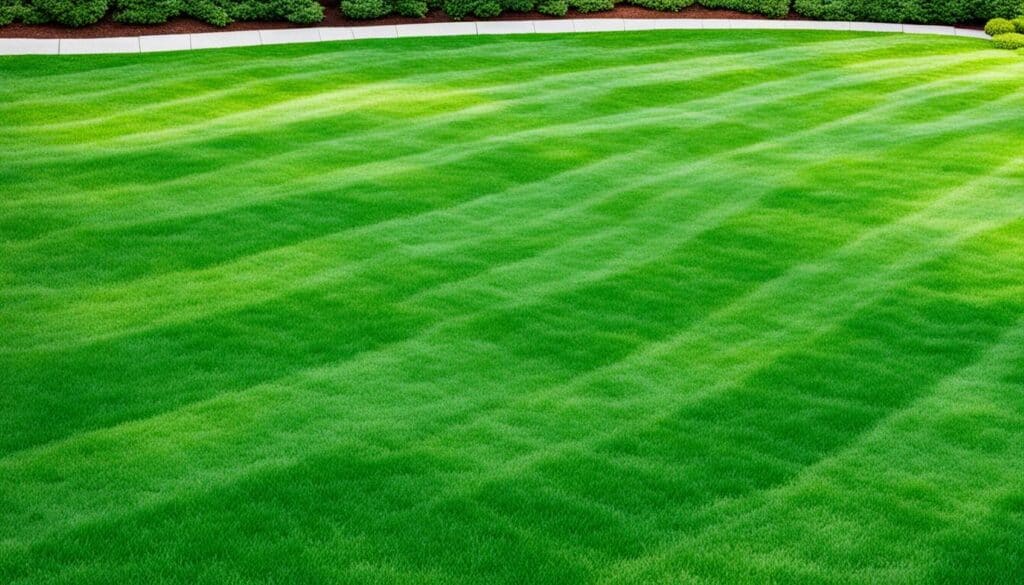
Proper Mowing Height
Keeping your grass at the right height after fertilizing is crucial. Experts say to keep it at 3-3.5 inches. This helps the grass grow strong roots and absorb nutrients better. Cutting it too short can stress the lawn, making it more prone to damage and less able to use the fertilizer well.
To find the best mowing height for your grass, talk to a local lawn care pro or check the guidelines from your grass seed supplier. Following these heights keeps your lawn healthy and ready to take in the fertilizer.
Grasscycling: Leaving Clippings on the Lawn
Grasscycling is another way to avoid messing up your fertilizer. It means leaving the clippings on the lawn after you mow. These clippings break down and give nutrients back to the soil, adding to the fertilizer you’ve applied. It’s good for your lawn and helps cut down on trash.
When you’re grasscycling, make sure to mow often so clippings don’t pile up and choke the grass. Try to cut off no more than one-third of the grass blade each time. This way, the clippings will break down fast and evenly, feeding your lawn consistently.
| Grass Type | Recommended Mowing Height |
|---|---|
| Kentucky Bluegrass | 2.5-3.5 inches |
| Perennial Ryegrass | 1.5-2.5 inches |
| Tall Fescue | 2.5-4 inches |
| Bermudagrass | 0.5-1.5 inches |
| Zoysiagrass | 0.5-1 inch |
Using the right mowing height and grasscycling can make your fertilizer work better and keep your lawn healthy. Adjust your mowing based on your grass type and local weather to get the best results.
Adjusting Mowing Schedule Around Fertilization
To get the most out of your lawn care, adjust your mowing times with fertilization. This way, your lawn gets the nutrients it needs without any issues with the fertilizer. It’s all about timing your mowing and fertilizing right.
Before you put down granular fertilizer, mow your lawn a day or two before. This makes sure the fertilizer spreads evenly and avoids mower damage. After fertilizing, wait the time suggested by the fertilizer before mowing again.
| Fertilizer Type | Mowing Interval Before Application | Mowing Interval After Application |
|---|---|---|
| Quick-Release Granular | 1-2 days | 2-3 days |
| Slow-Release Granular | 1-2 days | 3-5 days |
| Liquid Fertilizer | 1-2 days | Wait until dry |
Plan your lawn care ahead, considering both fertilizer and mowing times. This keeps your routine consistent and effective. It helps your grass get the nutrients it needs and avoids timing issues.
Always refer to the manufacturer’s instructions on the fertilizer packaging for specific guidelines on mowing intervals and application rates to achieve the best results for your lawn.
Adjusting your mowing for fertilization leads to a lush, healthy lawn. It’s ready to face environmental challenges and looks great all season.
How soon can i mow after granular fertilizer
It’s important to know when you can mow your lawn after using granular fertilizer. Mowing too soon can mess up the fertilizer’s absorption and cause uneven growth. It’s wise to wait 24-48 hours before mowing to let your lawn absorb the nutrients well and avoid damage.
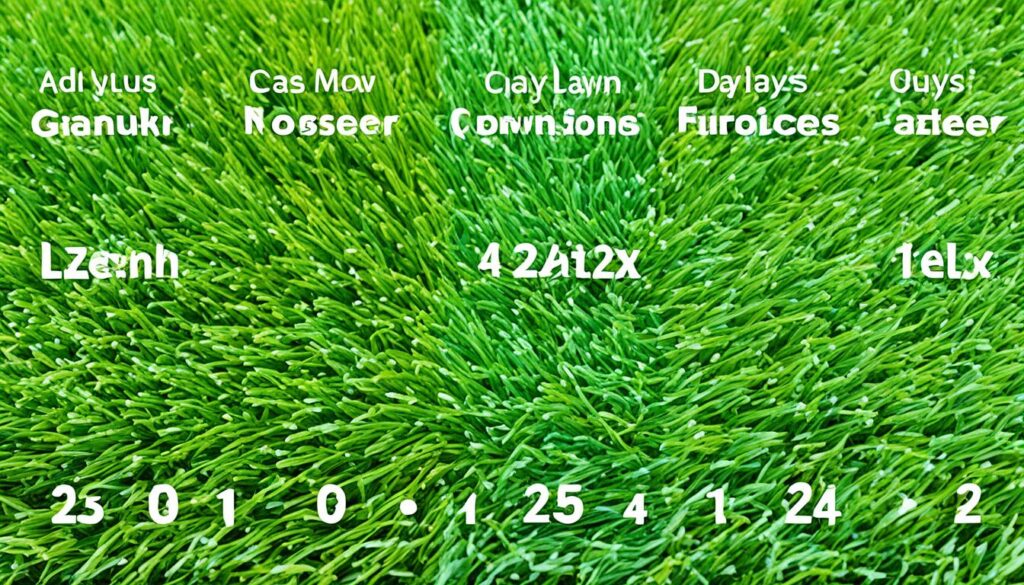
Quick Reference Chart for Mowing After Granular Fertilizer
This quick reference chart helps you remember when to wait before mowing with different fertilizers:
| Fertilizer Type | Waiting Period Before Mowing |
|---|---|
| Slow-Release Granular | 2-3 days |
| Fast-Release Granular | 1-2 days |
| Liquid Fertilizer | 4-6 hours |
| Organic Granular | 2-3 days |
Remember, these are general times. Always check the fertilizer’s instructions for the best waiting period.
Signs Your Lawn is Ready for Mowing Post-Fertilization
Here are signs that show your lawn is ready for mowing after fertilizer:
- The grass has fully dried, and there is no visible moisture on the blades
- Any visible fertilizer granules have dissolved or disappeared from the grass surface
- The lawn appears to be growing evenly, with no patches of discoloration or stunted growth
Waiting for these signs and following the recommended times helps your lawn get the most from the fertilizer. It also reduces the risk of damage from mowing too soon.
Common Mistakes to Avoid When Mowing After Fertilizing
To keep your lawn healthy and green after fertilizing, avoid common mistakes. These mistakes can reduce the fertilizer’s effectiveness and harm your grass. By knowing these pitfalls, you can keep your lawn looking great.
Mowing Wet Grass
One big mistake is cutting wet grass after fertilizing. This can cause problems like:
- Clumping of grass clippings, which can smother the lawn and prevent proper nutrient absorption
- Uneven cuts, resulting in a patchy and unattractive lawn appearance
- Damage to the lawn mower, as wet grass can clog the mower deck and dull the blades more quickly
To avoid these issues, wait until the grass is dry before mowing. This usually means waiting at least 24 hours after it rains or you water your lawn.
Cutting Grass Too Short
Cutting the grass too short after fertilizing is another mistake. It might look neat, but it’s not good for your lawn. Here’s why:
- Shorter grass has less surface area for photosynthesis, which can slow down growth and nutrient absorption
- Scalping the lawn can expose the soil, leading to increased water evaporation and weed growth
- Stressed grass is more susceptible to disease, pests, and environmental factors like extreme heat or cold
To keep your grass healthy and your fertilizer working well, stick to a proper mowing height. Most lawns do best when cut between 3 and 4 inches tall. This helps with deeper root growth, better nutrient uptake, and a healthier lawn.
| Mistake | Consequence | Solution |
|---|---|---|
| Mowing wet grass | Clumping, uneven cuts, mower damage | Wait until grass is dry before mowing |
| Cutting grass too short | Slower growth, exposed soil, stressed grass | Maintain a proper mowing height (3-4 inches) |
Avoid these common mistakes when mowing after fertilizing. This way, your lawn will get the most from the fertilizer and stay healthy and green all season.
Conclusion
To get a healthy, lush lawn, knowing when to mow after applying granular fertilizer is key. This guide helps you make sure your grass gets the most from fertilizers without harm. Wait 24 to 48 hours before mowing to let the fertilizer soak into the soil and roots.
When you do mow, follow the right techniques. Keep your mower at the right height and leave the clippings on the lawn. They act as a natural fertilizer. After fertilizing, watering your lawn helps it absorb the nutrients better. But, check the fertilizer instructions for the right watering amount.
Keep this guide for mowing after fertilizing close by. Adjust your lawn care as needed based on your grass and soil. With patience and careful attention, you’ll have a beautiful, healthy lawn that makes your home look great.
FAQ
How long should I wait to mow after applying granular fertilizer?
Wait 24 to 48 hours before mowing after applying granular fertilizer. This lets the fertilizer soak into the soil.
What happens if I mow too soon after fertilizing?
Mowing too soon can cause nutrient loss and uneven growth. It might also damage your lawn mower. The fertilizer won’t be fully absorbed, so mowing can remove it from the grass. This leads to waste and patchy growth.
How much water should I use after applying granular fertilizer?
Use about 1/4 to 1/2 inch of water after applying granular fertilizer. Water slowly and evenly to prevent runoff. This moisture helps dissolve the fertilizer, making nutrients available to the soil and roots.
What mowing techniques should I use to avoid disrupting the applied fertilizer?
Keep your grass at the right height for your type of grass. Cutting it too short can stress the lawn and affect how well it takes in fertilizer. Leaving grass clippings on the lawn can also provide nutrients as they break down.
How can I adjust my mowing schedule around fertilization?
Mow your lawn a day or two before fertilizing for even application. Wait the recommended time after fertilizing before mowing again. Plan your fertilization and mowing to keep your lawn care consistent and effective.
What are some common mistakes to avoid when mowing after fertilizing?
Never mow wet grass, as it can cause clumping and damage your mower. Also, don’t cut your grass too short. This can stress the lawn and make it harder for it to take in fertilizer nutrients.

